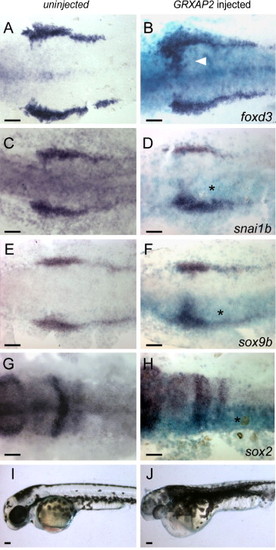Fig. 9
- ID
- ZDB-FIG-071204-33
- Publication
- Li et al., 2007 - Redundant activities of Tfap2a and Tfap2c are required for neural crest induction and development of other non-neural ectoderm derivatives in zebrafish embryos
- Other Figures
- All Figure Page
- Back to All Figure Page
|
Misexpression of Xenopus TFAP2A expands neural crest into the neural plates. (A, C, E, G, I) Uninjected control embryos or (B, D, F, H, J) embryos co-injected with RNA encoding β-galactosidase and GRXAP2, treated with dexamethasone at 8 hpf. (A–H) Embryos fixed at 11 hpf, and processed to reveal β-galactosidase activity (turquoise) (B, D, F, H) and expression of the indicated gene (dark blue). Expression of neural crest markers is seen to be expanded into the rostral domain of the neural plate on the injected side of the embryo (asterisk) (foxd3, 29 of 37 embryos; snai1b, 31 of 40 embryos; sox9b, 34 of 45 embryos) while expression of neural plate marker sox2 is decreased on the injected side (37 of 50 embryos). (I, J) Lateral views of live embryos at 36 hpf, showing a massive expansion of melanophores in the GRXAP2-injected embryo (27 of 34 RNA-injected embryos). Scale bars: 100 μm. |
Reprinted from Developmental Biology, 304(1), Li, W., and Cornell, R.A., Redundant activities of Tfap2a and Tfap2c are required for neural crest induction and development of other non-neural ectoderm derivatives in zebrafish embryos, 338-354, Copyright (2007) with permission from Elsevier. Full text @ Dev. Biol.

